
The emergence of DWDM is one of the most recent and important phenomena in the development of fiber optic transmission technology. This tutorial will introduce the fundamentals of DWDM technology, such as the components, optical amplifiers used in DWDM system, etc.
Components and Operation
DWDM is a core technology in an optical transport network. The essential components of DWDM can be classified by their place in the system. On the transmit side, there are lasers with precise, and stable wavelengths. On the link, there is optical fiber that exhibits low loss and transmission performance in the relevant wavelength spectra, in addition to flat-gain optical amplifiers to boost the signal on longer spans. On the receive side, there are photodetectors and demultiplexers using thin film filters or diffractive elements. Besides these components, optical add/drop multiplexers and optical cross-connect components may be used.
The main job of optical fibers is to guide lightwaves with a minimum of attenuation (loss of signal). Multimode fiber and single-mode fiber are the general two categories of optical fiber in use today. Single-mode fiber has a much smaller core that allows only one mode of light at a time through the core. As a result, the fidelity of the signal is better retained over longer distances, and modal dispersion is greatly reduced. These factors attribute to a higher bandwidth capacity than multimode fibers are capable of. For its large information-carrying capacity and low intrinsic loss, single-mode fibers are preferred for longer distance and higher bandwidth applications, including DWDM.
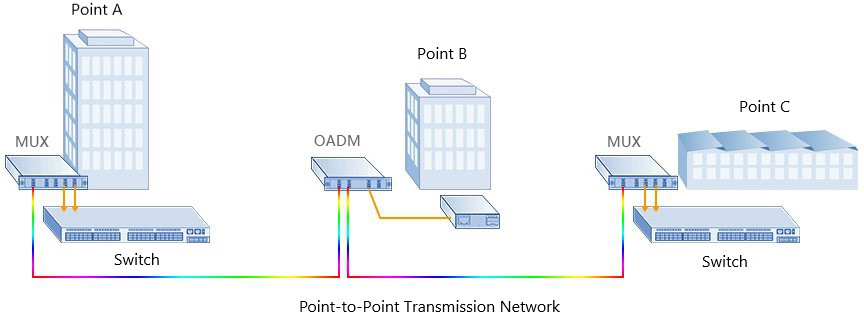
Erbium Doped Fiber Amplifier (EDFA)
By making it possible to carry the large loads that DWDM is capable of transmitting over long distances, the EDFA was a key enabling technology. Erbium is a rare-earth element that, when excited, emits light around 1.54 micrometers—the low-loss wavelength for optical fibers used in DWDM. The picture below shows a simplified diagram of an EDFA. A weak signal enters the erbium-doped fiber, into which light at 980 nm or 1480 nm is injected using a pump laser. This injected light stimulates the erbium atoms to release their stored energy as additional 1550-nm light. As this process continues down the fiber, the signal grows stronger.
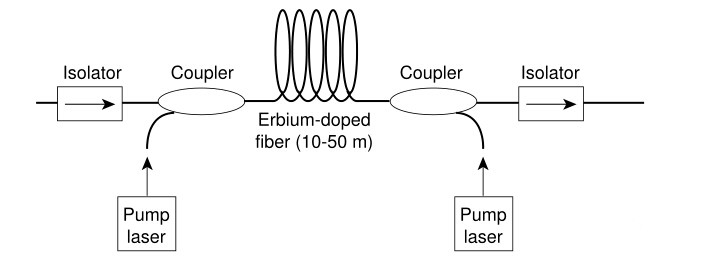
Multiplexers and Demultiplexers
As DWDM systems send signals from several sources over a single fiber, they must include some means to combine the incoming signals. This is done with a multiplexer, which takes optical wavelengths from multiple fibers and converges them into one beam. At the receiving end, the system must be able to separate out the components of the light so that they can be discreetly detected. Demultiplexers perform this function by separating the received beam into its wavelength components and coupling them to individual fibers. Demultiplexing must be done before the light is detected, because photodetectors are inherently broadband devices that cannot selectively detect a single wavelength.
In a unidirectional system, there is a multiplexer at the sending end and a demultiplexer at the receiving end shown in the following picture. Two system would be required at each end for bidirectional communication, and two separate fibers would be needed.
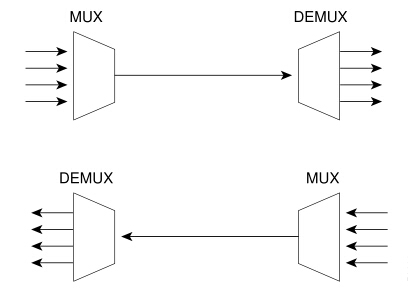
In a bidirectional system, there is a multiplexer/demultiplexer at each end and communication is over a single fiber pair.

Multiplexers and demultiplexers can be either passive or active in design. Passive designs are based on prisms, diffraction gratings, or filters, while active designs combine passive devices with tunable filters.
Optical Add/Drop Multiplexers (OADM)
Between multiplexing and demultiplexing points in a DWDM system, there is an area in which multiple wavelengths exist. It is often desirable to be able to remove or insert one or more wavelengths at some point along this span. An optical add/drop multiplexer performs this function. Rather than combining or separating all wavelengths, the OADM can remove some while passing others on. OADM is a key part of moving toward the goal of all-optical networks.
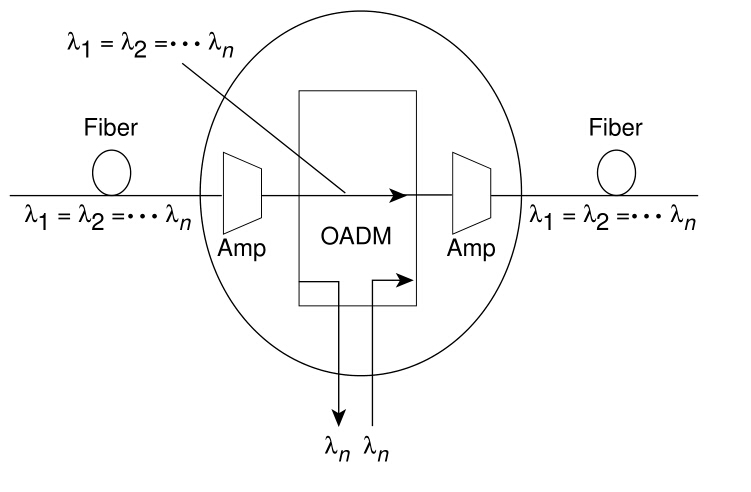
There are two general types of OADMs. The first generation is a fixed device that is physically configured to drop specific predetermined wavelengths while adding others. The second generation is reconfigurable and capable of dynamically selecting which wavelengths are added and dropped.
Operation of a Transponder Based DWDM System
Within the DWDM system, a transponder converts the client optical signal. The following picture shows the end-to-end operation of a unidirectional DWDM system.
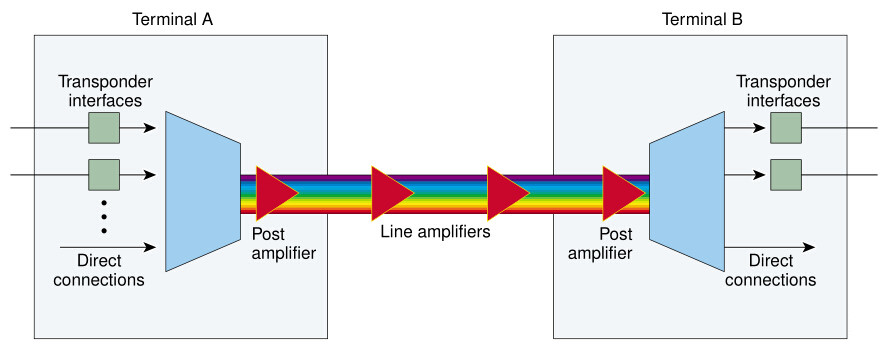
The following steps describe the system shown in the picture above.
1. The transponder accepts input in the form of standard single-mode or multimode laser. The input can come from different physical media and different protocols and traffic types.
2. The wavelength of each input signal is mapped to a DWDM wavelength.
3. DWDM wavelengths from the transponder are multiplexed into a single optical signal and launched into the fiber. The system might also include the ability to accept direct optical signals to the multiplexer; such signals could come, for example, from a satellite node.
4. A post-amplifier boosts the strength of the optical signal as it leaves the system (optional).
5. Optical amplifiers are used along the fiber span as needed (optional).
6. A pre-amplifier boosts the signal before it enters the end system (optional).
7. The incoming signal is demultiplexed into individual DWDM lambdas (or wavelengths).
8. The individual DWDM lambdas are mapped to the required output type (for example, OC-48 single-mode fiber) and sent out through the transponder.
→ Click to view the product